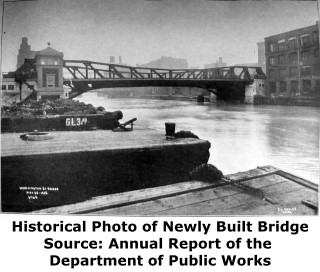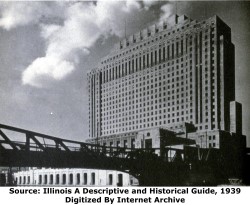We Recommend:
Bach Steel - Experts at historic truss bridge restoration.
Washington Boulevard Bridge

Primary Photographer(s): Nathan Holth
Bridge Documented: August 12, 2006 - June 13, 2021
Chicago: Cook County, Illinois: United States
Metal Rivet-Connected Pratt Pony Truss, Movable: Double Leaf Bascule (Fixed Trunnion) and Approach Spans: Metal Stringer (Multi-Beam), Fixed
1913 By Builder/Contractor: Strobel Steel Construction Company of Chicago, Illinois and Engineer/Design: City of Chicago
Not Available or Not Applicable
197.0 Feet (60 Meters)
303.5 Feet (92.5 Meters)
36 Feet (10.97 Meters)
1 Main Span(s) and 3 Approach Span(s)
16605326841

View Information About HSR Ratings
Bridge Documentation
View Archived National Bridge Inventory Report - Has Additional Details and Evaluation
View Historic American Engineering Record (HAER) Documentation For This Bridge
HAER Data Pages, PDF
View A Historical Article About This Bridge and Contractor Fitzsimons and Connell Dredge and Dock Company
View Details On A Failed Attempt To Appeal A Lawsuit Relating To This Bridge Design
This bridge celebrates its 100th Anniversary on May 26, 2013! Click Here To View A Commemoration Article By ChicagoLoopBridges.com! (Alternate PDF Format)
Overview of Bridge
This bridge is an example of the oldest design of the trunnion bascule bridges that employ a pony truss design for the superstructure. As such, this bridge is similar to bridges like the Chicago Avenue Bridge. This bridge design was developed by the Chicago Bureau of Engineering and represents the transition from the lighter-weight and less streamlined designs toward the smoother and more massive designs seen bridge bridges like on Clark Street. It also represents the abandonment of the earliest bascule bridge design which was a through truss. For this reason, this bridge design is known as the "second generation" Chicago bascule bridge design. The bridge tender buildings for this particular bridge are unique and interesting, but are modified from the original design. Based on original plans for this bridge, the bridge today is missing decorative finials that were mounted on top of the trusses at various panel points.

Above: View showing the bridge in 2021
The substructure of this bridge had to be carefully designed to straddle a subway tunnel that existed under the bridge when it was built. The substructure contractor for the bridge was the FitzSimons and Connell Dredge and Dock Company of Chicago and the superstructure contractor was the Strobel Steel Construction Company of Chicago.
The first bridge at this location was an 1875 iron swing bridge built by the American Bridge Company of Chicago and was 157 feet long and 31.5 feet wide. This bridge was replaced in 1891 when the former Madison Street Bridge was moved to this location. At this time, Washington Boulevard was called Washington Street.

100th Anniversary
This bridge was completed and opened on May 26, 1913. It celebrates its 100th Anniversary in 2013, a significant achievement that deserves to be recognized. Despite its age, the bridge remains in decent structural condition and is more than sufficient for the traffic it carries today. Click here to view a commemoration article by ChicagoLoopBridges.com. (Alternate PDF Format)
A Source of Conflict
This bridge is one of a number of bridges that the city of Chicago designed and built that resulted in a lawsuit by famous bridge engineer Joseph Strauss of the Strauss Bascule Bridge Company. The Washington Boulevard Bridge was specifically mentioned by Joseph Strauss in a presentation he gave where he discussed the similarities between his patent and the Chicago city design. The lawsuit centered around similarities in how the city supported its trunnions to the patented Strauss design. The diagram below, produced by Strauss, was intended to illustrate these similarities.
![]()
Historic Bridges of Chicago and Cook County


Chicago and Cook County are home to one of the largest collections of historic bridges in the country, and no other city in the world has more movable bridges. HistoricBridges.org is proud to offer the most extensive coverage of historic Chicago bridges on the Internet.
General Chicago / Cook County Bridge Resources
Chicago's Bridges - By Nathan Holth, author of HistoricBridges.org, this book provides a discussion of the history of Chicago's movable bridges, and includes a virtual tour discussing all movable bridges remaining in Chicago today. Despite this broad coverage, the book is presented in a compact format that is easy to take with you and carry around for reference on a visit to Chicago. The book includes dozens of full color photos. Only $9.95 U.S! ($11.95 Canadian). Order Now Direct From The Publisher! or order on Amazon.
Chicago River Bridges - By Patrick T. McBriarty, this is a great companion to Holth's book shown above. This much larger book offers an extremely in-depth exploration of Chicago's movable highway bridges, including many crossings that have not existed for many years. Order Now Direct From The Publisher! or order on Amazon.
View Historic American Engineering Record (HAER) Overview of Chicago Bascule Bridges (HAER Data Pages, PDF)
Chicago Loop Bridges - Chicago Loop Bridges is another website on the Internet that is a great companion to the HistoricBridges.org coverage of the 18 movable bridges within the Chicago Loop. This website includes additional information such as connections to popular culture, overview discussions and essays about Chicago's movable bridges, additional videos, and current news and events relating to the bridges.
Additional Online Articles and Resources - This page is a large gathering of interesting articles and resources that HistoricBridges.org has uncovered during research, but which were not specific to a particular bridge listing.
This bridge is tagged with the following special condition(s): Unorganized Photos
![]()
Photo Galleries and Videos: Washington Boulevard Bridge
Bridge Photo-Documentation
Original / Full Size PhotosA collection of overview and detail photos. This gallery offers photos in the highest available resolution and file size in a touch-friendly popup viewer.
Alternatively, Browse Without Using Viewer
![]()
Bridge Photo-Documentation
Mobile Optimized PhotosA collection of overview and detail photos. This gallery features data-friendly, fast-loading photos in a touch-friendly popup viewer.
Alternatively, Browse Without Using Viewer
![]()
Raising The Bridge, Elevation
Full Motion VideoStreaming video of the bridge. Also includes a higher quality downloadable video for greater clarity or offline viewing.
![]()
Lowering The Bridge, Portal View
Full Motion VideoStreaming video of the bridge. Also includes a higher quality downloadable video for greater clarity or offline viewing.
![]()
Raising The Bridge, Elevation
Full Motion VideoNote: A considerable pause in the lift process occurs after the eastern leaf is raised slightly. Note: The downloadable high quality version of this video (available on the video page) is well worth the download since it offers excellent 1080 HD detail and is vastly more impressive than the compressed streaming video. Streaming video of the bridge. Also includes a higher quality downloadable video for greater clarity or offline viewing.
![]()
Additional Unorganized Photos
Original / Full Size PhotosA supplemental collection of photos that are from additional visit(s) to the bridge and have not been organized or captioned. This gallery offers photos in the highest available resolution and file size in a touch-friendly popup viewer.
Alternatively, Browse Without Using Viewer
![]()
Additional Unorganized Photos
Mobile Optimized PhotosA supplemental collection of photos that are from additional visit(s) to the bridge and have not been organized or captioned. This gallery features data-friendly, fast-loading photos in a touch-friendly popup viewer.
Alternatively, Browse Without Using Viewer
![]()
Maps and Links: Washington Boulevard Bridge
Coordinates (Latitude, Longitude):
Search For Additional Bridge Listings:
Bridgehunter.com: View listed bridges within 0.5 miles (0.8 kilometers) of this bridge.
Bridgehunter.com: View listed bridges within 10 miles (16 kilometers) of this bridge.
Additional Maps:
Google Streetview (If Available)
GeoHack (Additional Links and Coordinates)
Apple Maps (Via DuckDuckGo Search)
Apple Maps (Apple devices only)
Android: Open Location In Your Map or GPS App
Flickr Gallery (Find Nearby Photos)
Wikimedia Commons (Find Nearby Photos)
Directions Via Sygic For Android
Directions Via Sygic For iOS and Android Dolphin Browser
USGS National Map (United States Only)
Historical USGS Topo Maps (United States Only)
Historic Aerials (United States Only)
CalTopo Maps (United States Only)











